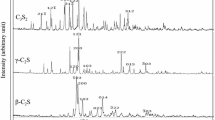The introduction of 24 wt.% powder of monocalcium phosphate monohydrate after firing at 1200°C into an impregnating suspension based on hydroxyapatite powder heat-treated at 800°C effects the formation of calcium phosphate ceramic foam based on β-tricalcium phosphate and β-calcium pyrophosphate. Successive application of hydroxyapatite and biomimetic apatite to calcium phosphate ceramic foam effects greater strength and enrichment with α-tricalcium phosphate and hydroxyapatite. Multiphase calcium phosphate ceramic foam possesses porosity 35 – 60%, static strength to 0.08 MPa, and heightened bioactivity on account of the biomimetic apatite layer.



Similar content being viewed by others
Notes
Here and below, content by weight: wt.%.
References
M. Tavoni, M. Dapporto, A. Tampieri, and S. Sprio, “Bioactive calcium phosphate-based composites for bone regeneration,” J. Composites Sci., No. 5, 227 – 254 (2021).
T. V. Safronova, “Inorganic materials for regenerative medicine,” Inorg. Mater., 57(5), 443 – 474 (2012) [Neorg. Mater., 57(5), 467 – 499 (2021)].
P. Dee, H. Y. You, S. H. Teoh, and H. Le Ferrand, “Bioinspired approaches to toughen calcium phosphate-based ceramics for bone repair,” J. Mechan. Behavior Biomed. Mater., No. 112, Article ID 104078 (2020).
S. M. Barinov and V. S. Komlev, “Approaches to the fabrication of calcium phosphate-based porous materials for bone tissue regeneration,” Inorg. Mater., 52(4), 339 – 346 (2016) [Neorg. Mater., 52(4), 383 – 391 (2016)].
J. Wang, M. Wang, and F. Chen, “Nano-hydroxyapatite coating promotes porous calcium phosphate ceramic-induced osteogenesis via BMP/Smad signaling pathway,” Int. J. Nanomedicine, 14, 7987 – 8000 (2019).
T. V. Safronova, S. A. Korneichuk, V. I. Putlyaev, and V. K. Krut’ko, “Ceramics based on calcium hydroxyapatite synthesized from calcium acetate, calcium hydroxide, and potassium hydrophosphate,” Glass Ceram., 69, No. 1 – 2, 30 – 36 (2012) [Steklo Keram., No. 1, 30 – 36 (2012)].
B. Huang, G. Caetano, C. Vyas, et al., “Polymer-ceramic composite scaffolds: the effect of hydroxyapatite and β-tricalcium phosphate,” Materials, 11(1), 129 – 142 (2018).
S. V. Dorozhkin, “Calcium orthophosphate-based bioceramics,” Materials, 6, 3840 – 3942 (2013).
V. K. Krut’ko, A. I. Kulak, O. N. Musskaya, and T. V. Safronova, “Thermal evolution of calcium phosphate ceramic foam obtained on the basis of hydroxyapatite and monocalcium phosphate monohydrate,” Fiz.-Khim. Aspekty Izuch. Klasterov, Nanostructur Nanometar., No. 11, 615 – 623 (2019).
M. Bohner, “Bioresorbable ceramics,” in: Degradation Rate of Bioresorbable Materials (2008), pp. 95 – 114.
H. Takadama, M. Hashimoto, M. Mizuno, and T. Kokubo, “Round-robin test of SBF for in vitro measurement of apatite-forming ability of synthetic materials,” Phosphorus Res. Bull., No. 17, 119 – 125 (2004).
Y. H. Chan, “Comparative in vitro osteoinductivity study of HA and α-TCP/HA bicalcium phosphate,” Int. J. Appl. Ceram. Tech., No. 12, 192 – 198 (2015).
N. Ozgür Engin and A. Cüneyt Tas, “Manufacture of macroporous calcium hydroxyapatite bioceramics,” J. Eurp. Ceramic Soc., 19, 2569 – 2572 (1999).
F. Çalýþkan, Z. Tatlý, and A. Sonkaya, “Fabrication of bioactive high porous hydroxyapatite ceramics,” APJES, III-IP, 8 – 13 (2015).
H. Yoshikawa, N. Tamai, Ts. Murase, and A. Myoui, “Interconnected porous hydroxyapatite ceramics for bone tissue engineering,” J. Royal Soc. Interface, 6, S341 – S348 (2009).
A. Iatsenko, O. Sych, and T. Tomila, “Effect of sintering temperature on structure and properties of highly porous glass-ceramics,” Proc. Appl. Ceram., 9(2), 99 – 105 (2015).
S. Deville, E. Saiz, and A. P. Tomsia, “Freeze casting of hydroxyapatite scaffolds for bone tissue engineering,” Biomaterials, 27(32), 5480 – 5489 (2006).
S. N. Gorodzha, M. A. Surmeneva, I. I. Selezneva, et al., “Investigation of the morphology and structure of porous hybrid 3D scaffolds based on polycaprolactone, including silicon-containing hydroxyapatite,” Pov-st’. Rentgen., Sinkhrotr. Neitr. Issled., No. 7, 92 – 102 (2018).
J. I. G. Ocampo, D. M. E. Sierra, and C. P. O. Orozco, “Porous bodies of hydroxyapatite produced by a combination of the gel-casting and polymer sponge methods,” J. Adv. Res., 7, 297 – 304 (2016).
V. K. Krut’ko, A. I. Kulak, O. N. Musskaya, et al., “Calcium phosphate foam ceramic based on hydroxyapatite – brushite powder mixture,” Glass Ceram., 76(3 – 4), 113 – 118 (2019) [Steklo Keram., No. 3, 38 – 44 (2019)].
V. K. Krut’ko, A. I. Kulak, O. N. Musskaya, et al., “Calcium phosphate foam ceramics with controlled bioactivity,” Fiz.-Khim. Aspekty Izuch. Klasterov, Nanostr. Nanomater., No. 10, 374 – 382 (2018).
Y. Huang, W. Huang, L. Sun, and Q. Wang, “Phase transition from α-TCP into β-TCP in TCP/HA composites,” Int. J. Appl. Ceram. Tech., 7(2), 184 – 188 (2010).
K.-T. Chua, Sh.-F. Ou, Sh.-Y. Chen, et al., “Research of phase transformation induced biodegradable properties on hydroxyapatite and tricalcium phosphate based bioceramic,” Ceram. Int., No. 39, 1455 – 1462 (2013).
L. Yubao, Zh. Xingdong, and K. de Groat, “Hydrolysis and phase transition of alpha-tricalcium phosphate,” Biomaterials, 18(10), 737 – 741 (1997).
G. Piga, A. Amarante, C. Makhoul, et al., “β-Tricalcium phosphate interferes with the assessment of crystallinity in burned skeletal remains,” J. Spectroscopy, Art. 5954146, 1 – 10 (2018).
H. A. Bethe, “Statistical theory of superlattices,” Proc. Royal Soc. A: Mathem., Phys. Eng. Sci., 150(871), 552 – 575 (1935).
R. M. Hill and L. A. Dissado, “The temperature dependence of relaxation processes,” J. Phys. C: Solid State Phys., 15(25), 5171 – 5193 (1982).
Author information
Authors and Affiliations
Corresponding author
Additional information
Translated from Steklo i Keramika, No. 12, pp. 15 – 21, December, 2021.
Rights and permissions
About this article
Cite this article
Krut’ko, V.K., Maslova, L.Y., Musskaya, O.N. et al. Calcium Phosphate Ceramic Foam Obtained by Firing a Hydroxyapatite – Monocalcium Phosphate Monohydrate Powder Mixture. Glass Ceram 78, 476–480 (2022). https://doi.org/10.1007/s10717-022-00435-y
Published:
Issue Date:
DOI: https://doi.org/10.1007/s10717-022-00435-y




